1.
Koh Kong Town and Province
Koh Kong is a town in the southwestern corner of Cambodia. It's the province capital of Koh Kong Province. The province comprises large parts of the Cardamom Mountains, the southwestern coastal plains with their large mangrove forests and some islands in the Gulf of Thailand. It's position is quite an isolated in Cambodia; there are no bigger places between Koh Kong and the 271km away lying capital Phnom Penh. The next coastal city east is Sihanoukville. Only the completition of the four bridges along national highway 48 (NH48) connected Koh Kong with the inner part of the country.
Koh Kong Bridge
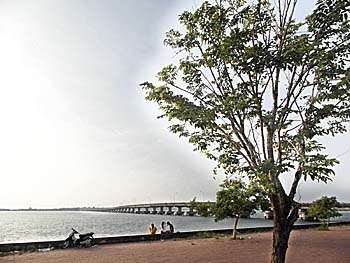
Cambodia's longest bridge, built by Thailand. Factually I have never seen a bridge in Cambodia built from Cambodia. It's always China, Vietnam, Japan, Korea or, as here, Thai investors who built the bridges.
The bridge is crossing a seabay which forms also the mouth of Kah Bpow River, coming out of the Cardamom Mountains. Image by Asienreisender, 12/2013
The town of Koh Kong is close to the Thai border at Hat Lek. To reach the border one has to pass another new bridge over the Kah Bpow River. For crossing the bridge a toll is charged. The next bigger (provincial) town in Thailand is Trat. The distance to Bangkok is roughly 450km.
The dusty (or muddy, depending on the weather) hole at the Cambodian border to Thailand's Trat Province was for a time mostly a transfer point for travellers who came from Thailand and were too late to get a bus to other places in Cambodia. The most buses leave in the morning, and the arrivals from Bangkok usually don't reach the border before midday or early afternoon. It's due to the lousy and uncoordinated transport system that people get stuck here in this bottleneck.
Koh Kong Town
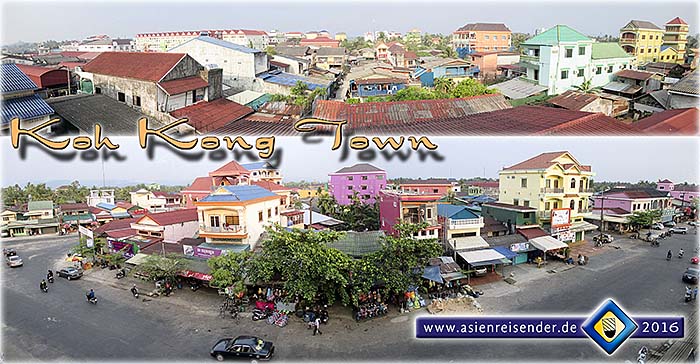
The town seen with the bird's eye. It looks like any other Cambodian place nowadays; it's all new and of a certain, for Cambodia typical style. Moreover, it's all of a very low quality, from top to bottom - The roofs leak, the walls are thin, the windows are ill-isolated, the electronic installations are bad, the plumming is disfunctional and often broken or unusable - in short words, these whole new cities are brandnew rubbish.
Being here it's hard to imagine that the whole place, as it looks now, is younger than 15 years. Almost all of these buildings have been constructed after the final agreement between the Cambodian government and the Khmer Rouge after 1998. Images and photocomposition by Asienreisender, 2/2016
Koh Kong Bus Station

This depressing place is Koh Kong's bus station. As so often there is no clear information about departure times, travel times and prices. For the waiting time serves the restaurant left side. If a bus does not collect 'enough' passengers, it won't go. 'Enough' in Cambodia is about four persons on three seats. Foreigners are always charged more than locals. Image by Asienreisender, 12/2013
Tourism
In the last years the town has itself become an increasing tourist destination. Mountain trekking and trips to Koh Kong Island are on the list for the classic tourists, while gambling in Koh Kong Resort & Casino is on the list of the most Thais who come here. Still, the number of western tourists is comparably small.
Fishing Boats
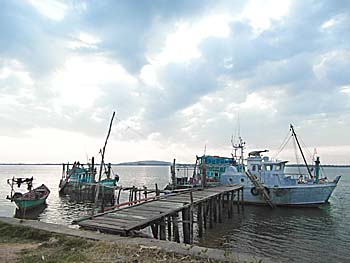
Fishing boats at a small pier in Krong Koh Kong. Image by Asienreisender, 12/2013
At the riverfront are a few restaurants who are specialized on western tourists. The mainstream goes to Ritthy, a sly Khmer business monkey, who combines a restaurant, a guesthouse and a tour agency. However, service is sloppy, information often weired and not trustworthy. Rip-offs happen. A better source for information is 'Fat Sam's' restaurant at the roundabout with the statue of a women with two baskets.
These tour operators have a vital interest in selling tour and don't like it when people go by their own, what is in the verymost cases an easy thing to do. A journey to Koh Kong Island therefore is not easy, for one needs boat transport. It seems that accommodation and food on the island are ridiculously overpriced. Koh Kong has apparently turned into a tourist trap.
The town of Koh Kong has nothing in common with the skillfully planned and aesthetic design of the French made town of Kampot. Koh Kong is from it's beginning on an chaotic, wild growth.
There is not much to do in Koh Kong, the province capital, apart from strolling along the waterfront. It's promenade looks similar to the one at Kampot's waterfront, but it's wider and shabbier. Means dirtier and more broken.
The waterfront here is situated along a long, pointed seabay which is blending it's saltwaters with the sweetwaters from the Kah Bpow River. It's said around here were still some of the Irrawaddy Dolphins living, as at the shores of neighbouring Trat Province / Thailand. The Bangkok Post reported in the last years repeatedly of severe losses among the decreasing dolphin population due to industrial impacts.
In Koh Kong is also one of the notorious 'Special Economic Zones' established. Import-export business... It's the area between the new bridge and the border.
The Riverfront of Koh Kong
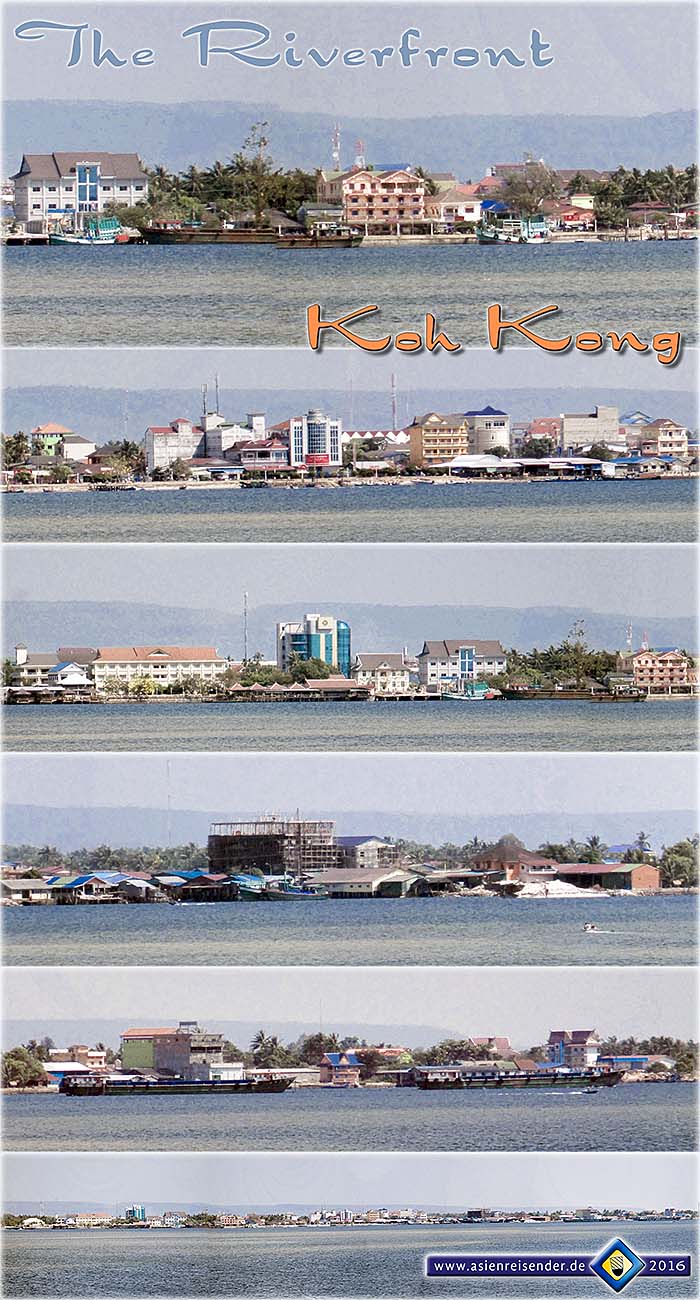
Koh Kong's riverfront is a pretty mixed-up composition. Some of the better hotels, some of the cheaper guesthouses, a broken and dirty promenade with cheap foodstalls, a few tourist restaurants, a port and some industry. Also fishing boats dock here. Images and photocomposition by Asienreisender, 2/2016
Stilt Houses in Koh Kong Town

Some of the typical Cambodian stilt houses at the banks of a tributary river to the bay. The road parallel to the promenade in Koh Kong is right hand. Image by Asienreisender, 12/2013
The Cambodian / Thai Border
KKrong Koh Kong town is the capital of Koh Kong Province and it is still eleven kilometers away from the Thai border. At the border itself is at least one of the notorious Cambodian casinos placed. It's attracting gamblers from Thailand, where casinos and all kinds of gambling for money are prohibited. Next door to the casino was a safari park, probably for if the gamblers come with their whole family and the bored kids make trouble. It was closed in 2015, and the animals have been brought to Phnom Penh, according to the Phnom Penh Post.
Koh Kong Resort & Casino

The main tourist attraction of Koh Kong is certainly the casino. Thai is the favourite language spoken inside. It's just 50m behind the border. Images and photocomposition by Asienreisender, 2/2016
Special Economic Zone
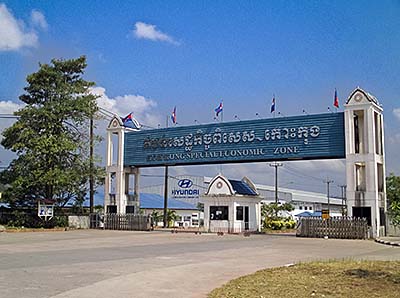
Koh Kong Special Economic Zone is the area between the river and the border. Here we see the entrance gate to the main industrial park. It's, as anything of it's kind in nowadays Cambodia, under massive expansion and growing into the offshoots of the mountains. Image by Asienreisender, 2/2016
However, the connection between Koh Kong town and the Thai border checkpoint is a gap in the transport system. It's filled by the omnipresent tuktuk or motorbike drivers. They of course try to make a tourist a 'good price'. Besides there is the new bridge to cross, and it cost's an additional fee. Drivers always want to make their customers pay the fee. When arranging a drive they wouldn't tell their customers before, so it's one of these little surprises when one get's served an additional bill. The bridge is with 1,900m length the longest bridge in Cambodia. Built by Thai investment and construction.
There are also some frauds running on the Cambodian side of the border. Best to ignore all the guys with the 'baggage service' and the 'passport service' and to go straight to the immigration office. For a visa at arrival for 30 days the official charge is now 30 US$. The officers try to make it (much) more expensive and want to get payed a much higher fee in Thai baht. It's hard to deal with them, because one needs the bloody visa, and if the gangsters in uniform don't get what they want they can easily refuse to give one out.
Koh Kong Border Checkpoint

The Cambodian custom office in Koh Kong. It's one of the smaller border posts and usually there is not much traffic. Images and photocomposition by Asienreisender, 2/2016
When coming from Thailand one is suffering a clear cultural decline. Everything is three levels lower than in Thailand. Particularly the behaviour of the locals, if you compare the polite, helpful and nicely reserved Thai People with the mannerless, noisy, impertinent and semi-barbarous Cambodian peasants.
2.
Surroundings
Since 'Koh' actually is Thai language and means 'island', one might wonder about the name for the land-based town. However, there is a Koh Kong Island some 20km beeline southwards. Besides there is so called 'Beach 2000' not far from town, reachable allegedly by boats only. It's popular among Khmers.
Forest Fires
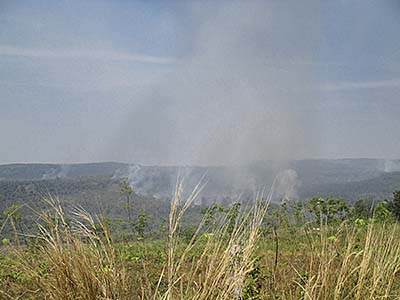
Burning rainforest in the Cardamom Mountains, some 15km above Koh Kong Town in the mountains. Arson is a daily happening in the dry season. Image by Asienreisener, 2/2016
The long coastlines are still mostly undeveloped, although the villages in Koh Kong Province are growing fast. That causes an increasing impact on the mangrove forests. Particularly shrimp farms grew extensively in the last years. They are preferably built on the grounds of former mangrove forest, which is removed by caterpillars then.
Around the place are the offshoots of the Cardamom Mountains. There is a waterfall riverupwards in the forest, close to NH48, short before the first bridge. It's Tatai Waterfall and is kind of an attraction. It wouldn't be Cambodia if there were not a bunch of locals who put a bar up and hold their hands of - a dollar for nothing.
The place is surrounded by the last remaining large virgin forests in Cambodia. When following the national highway NH 48 east along the coastline, the first 100 or so kilometers lead through the tropical rainforest of the Cardamom Mountains, what is a much nicer and authentic surrounding than the monotonous rubber or oil palm monocultures who coin great parts of Southeast Asia nowadays.
The rich wildlife of the tropical rainforests in the Cardamom Mountains are targeted for the local and international market. Wildlife is traditionally part of the local's diet. Local restaurants and the fresh markets are supplied by hunters and poachers who go permanently hunting in the forests. Other animal products like teeth, bones, fures, skins and processed organs are sold als trophies or Chinese medicine. In the past were reportedly Thai traders in town and other sources speak of sells into Trat Province.
The Landscapes of Koh Kong
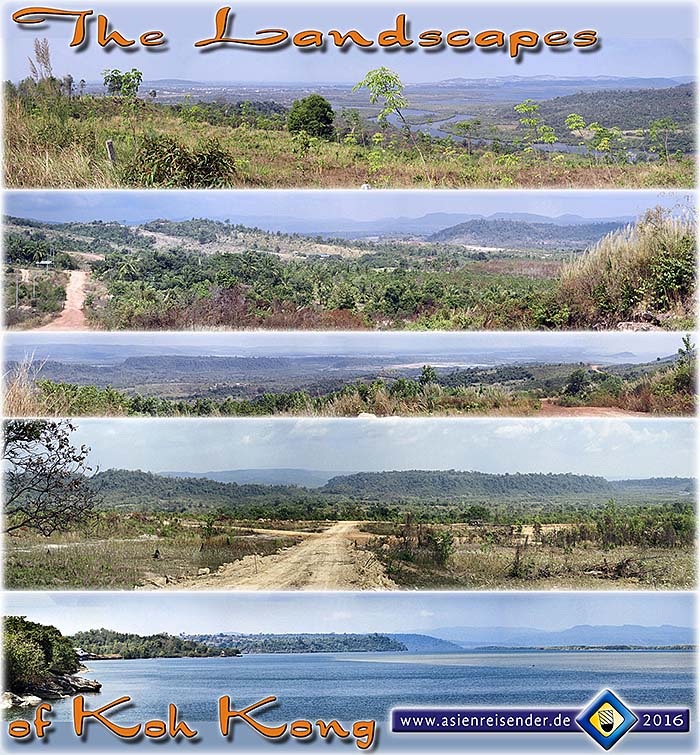
Mountains, rivers, coastlines - the landscapes of Koh Kong are various. Images and photocomposition by Asienreisender, 2/2016
National Highway 48

Between Koh Kong Town and the third bridge at Andaung Toeuk, NH48 leads mostly through dense rainforest. This long stretch lasts over about 100km and the forest here is under protection. However, the road itself means of course a heavy impact for the nature, and a number of animals, like the pileated gibbons, don't cross it and have their habitat therefore cut in two pieces. Traffic is growing fast.
Over parts, longer stretches to the right and the left have been already deforested and are recovering now. Nevertheless, the sensitive top soil of the rainforest has been gone and there is bare, white sand to see. Very few roads split from the national road, but at many spots are locals with bigger bags to see who enter the forests. They go poaching and gathering whatever they can use or sell. At one spot near the road I saw a fire and heared shots in the forest. Supposedly locals set the fire and waited for nocturnal animals leaving their hideouts to kill them. Image by Asienreisender, 2/2016
Nevertheless, and despite the fact that the forests are under official protection, most of the big, valuable trees have already been cut by loggers. The surrounding hilly forests were one of the last refuges of the Khmer Rouge until the late 1990s. In that time Koh Kong had a notorious reputation for the smuggling of wood and animals as well as for banditry and prostitution. And probably human trafficking as well. In fact these activities are still going on, although the situation partially improved.
Sre Ambel River

At Sre Ambel bridge, one of the four bridges over rivers who are coming out of the Cardamom Mountains. Sre Ambel itself is a dirty nest, with a couple of contract restaurants of the bus operators.
At a closer look you can see left the roof of the tin hut of a sunken ship inmiddle of the river. There is some sand dredging at the place as well, supplying the building industries or Singapores urge for landfilling. Image by Asienreisender, 12/2013
Besides, already from the balcony of my guesthouse I see the forests on the nearby mountain slopes in fire. A permanent haze is in the air (2/2016).
Koh Kong's connection to inner Cambodia follows poorly sealed NH 48. One has to pass four new bridges (built from Thai investment and certainly by Thai companies). One of the bridges is at Sre Ambel (138km away), where a few contract restaurants are situated. Usually all the buses have a stop here, getting a commission for bringing guests.
It's said the road was carved into the jungle just in 2003 by the Thai army. In 2006 these new bridges didn't exist. River crossing was done by ferries. The so called 'road' was in 2006 in fact a terrible desaster of a dirt road, actually a long row of potholes and craters. But things improved. Now there are the bridges, and the road is merely a very bad one.
Shortly behind Sre Ambel the road ends up into NH 4, to Phnom Penh (left) or Sihanoukville respectively Kampot (right turn).
The Mangrove Forests at Peam Krasaop

The population is growing rapidly and needs more and more space. Human encroachment happens not only into the mountains, but also into the yet large mangrove forests along the coastline. More and more boats are around, who are hellish loud; particularly the longtail boats. That's certainly also disturbing for the animals above and below the water. Worse is the increasing amount of fishing activities, particularly the rough ones with explosives.
Peam Krasaop is a wildlife sanctuary. Nevertheless, the community has built a resort inmiddle of the mangroves; however, apart from a brandnew restaurant and some wooden shops are the bungalows all broken. The project failed before it startet; the rooms were never in use. The impact on the nature remains.
Still, there are long, concrete and wood walkways who lead into the mangroves. At the end are a few shacks built where one can get food from other nearby restaurants who are run by local families. Unfortunately do most of the guests throw there one way plastic dishes and cutlery immediately after use into the nature. They come also never without at least a blaring mobile phone. Images and photocomposition by Asienreisender, 2/2016
Botum Sakor National Park

The large peninsula between Trapaeng Rung and Andaung Toeuk has been declared Cambodia's biggest national park, Botum Sakor. The area is coined by rollig hills, a few remaining patches of lowland rainforest, savannah, swamps and, along the coastline of the Gulf of Thailand, mangrove forests.
The peninsula houses a great biodiversity of animals and plants, many of them unique in the world and many of them are endangered to extinct. Elephants, a few last Indochinese tigers, Siamese and saltwater crocodiles are allegedly still living here as well as estimated 10% of the global population of pileated gibbon monkeys and some remaining Sunda pangolins. There has been little scientific research here yet. Wildlife Alliance classified the park as one among 25 biodiversity hotspots on the globe.
As everywhere in the world the destruction of this unique habitate is going on. One can see easily with his own eyes that a grand style development of the area is undergoing. Take alone the huge new road which leads over many kilometers from Andaung Toeuk southwards to the coast with a new, luxurious resort and a gulf course. The road is much broader than NH48, and all along it to the right and the left one sees large-scale degradation of the nature. The road cuts habitats for many animals who don't pass them; it's the same with NH48, which separates the peninsula from the Cardamom Mountains.
Plantations replace rainforest, an artificial lake killed a forest, more building activities are on the way. The government gave a number of these notorious land concessions to national and international companies who develop the land. There are fruit planations, rubber plantations and palmoil plantations. An agreement on the construction of a new hydropower dam has been signed in end 2012. Illegal logging happens since many years in an apparently incresing speed, according to satellite images. Poaching is rampant as well, partially for the diet of the local population, partially to satisfy the market for Chinese medicine. Images and photocomposition by Asienreisender, 2/2016
Sand Dredging in Koh Kong
Compared to another threat of the nature the above mentioned human encroachment is little business. Sand dredging endangers the mangrove habitats at Koh Kong. Since the first sand mining in the province started in 2008, parts of the nature suffered a heavy damage and hundreds of families have lost their livelihoods.
Singapore is the worlds largest sand importer. Most of the sand from Koh Kong goes to the island state at the tip of the Malay Peninsula. Whole beaches, riverbeds and islands fall victim to sand mining. Fishing grounds and other habitats get destroyed. The two involved sand mining companies 'Direct Access' and 'International Rainbow' are blamed by local activists from Mother Nature to violate all their obligations concerning environmental and social standards. Prior to the mining activities, local communities were not properly consulted and "no serious social and environmental impact assessment were ever conducted" (see Mother Nature's homepage). Most of the sand is getting smuggled out of Cambodia to Singapore.
Sand Transporters on Kah Bpow River

There are frequently barges to see who are going downstream on Kah Bpow River, passing Koh Kong's river promenade. It's claimed they unload their freight on large vessels who will leave to Singapore. Images and photocomposition by Asienreisender, 2/2016
Sand is becomming a scarce source. For a documentary on the topic check 'Sand Wars' on 'Youtube'.
Sand Dredging at Trapaeng Rung

The second bridge from Koh Kong over the Trapaeng Rung River. More sand dredging happens also at Sre Ambel. Image by Asienreisender, 2/2016
3.
A History of Koh Kong
I don't see a hint for Koh Kong having a long history. There are defenitely no Angkorean traces in the region, and probably the place had merely a village until the mid 20th century.
In the Second World War, from 1941 until 1946, Koh Kong was under Thai control but had to be given back to Cambodia.
However, after the fall of Democratic Kampuchea and the withdrawel of the Khmer Rouge the place was a spot of war activities until the very end of Khmer Rouge resistance in 1998.
On April 21st 1984, the Khmer Rouge captured Koh Kong and hold it for a day and a night. According to their own announcements they killed more than 1,100 Vietnamese troops. A year later an outpost around Koh Kong was the scene of a bloody attack in which according to the Khmer Rouge another 28 Vietnamese troops were killed. As late as in end 1998 Koh Kong Casino was attacked and considerably damaged. A Thai gambler got killed in that.
Still for the next ten years the area of Koh Kong was, due to it's remoteness, notorious for banditry, human trafficing, wild animal smuggling, illegal logging, prostitution, gambling and a high rate of HIV/AIDS. The situtation improved only due to the improved road connection.
In the 1980s the population of Koh Kong was still a very small. The government encouraged migration to the remote place and it's estimated having an growth rate of 16% per year now. One sees that here as everywhere in Cambodia the concrete cancer is gorging it's way in all directions, on the coast of the mountain forests as well as the mangrove forests along the sea shores.
A 19th Century Travel Report
One of the famous 19th century explorers, Henri Mouhot, came along the Cambodian coast in the year 1859. In his report he is mentioning the island(s) of Koh Kong shortly:
![]() The rain falling without intermission, we could not keep the fire alight to cook our rice, and for four days remained half-lying in the boat, scarcely able to move in the narrow space left for us, and our clothes clinging to us with wet. At last, on the fifth day, we had the pleasure of seeing the sky clear up and the wind change. (...)
The rain falling without intermission, we could not keep the fire alight to cook our rice, and for four days remained half-lying in the boat, scarcely able to move in the narrow space left for us, and our clothes clinging to us with wet. At last, on the fifth day, we had the pleasure of seeing the sky clear up and the wind change. (...)
At daybreak we perceived, about ten miles distant, the first of the islands of Koh-Kong. It is smaller than Koh-Chang, and neither so imposing in general appearance nor having such a splendid range of peaked hills. The island is nearly a desert, but it produces the beautiful cardamom, as also gamboge, collected from the bamboos, which the natives split open when hard.
I soon forgot the miseries of the first part of my voyage, and was amply recompensed by the shifting scenes of beauty presented to us by the group of islands we were passing. At length we reached the advanced posts of the pirates of Komput, from the heights of which they keep a look-out, and, as soon as a sail comes in sight, make preparations for an attack.![]()
Henri Mouhot, Travels in the Central Parts of Indochina, Volume I, p. 175/176